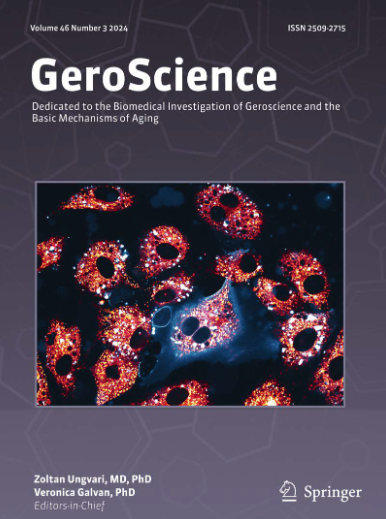神经酸和15-epi-PGA1介导AD痴呆全身性线粒体功能障碍。
IF 5.3
2区 医学
Q1 GERIATRICS & GERONTOLOGY
引用次数: 0
摘要
全身性线粒体功能障碍在阿尔茨海默病(AD)的病理生理中是明显的。然而,导致生物能量下降的因素仍不清楚。本研究利用认知正常、轻度认知障碍和痴呆老年人的血清样本,确定AD背景下可驱动线粒体功能障碍的循环分子。我们使用质谱法测量脂质代谢物的丰度,并应用分层选择标准来鉴定候选的“有丝分裂抑制”分子。这些标准是基于以下因素的相关性:(1)全血清样本对naïve细胞的体外生物能量效应,(2)血清供者血细胞的生物能量能力,以及(3)通过改进的迷你精神状态测试测量的认知能力。通过检测其对神经元、成肌细胞和成纤维细胞的体外生物能量效应,验证了mitto抑制脂质候选物。我们的研究结果表明,与认知正常的人相比,痴呆患者的神经酸和15-epi前列腺素A1 (15-epi- pga1)升高。重要的是,这两种代谢物在体外抑制多种细胞类型的线粒体功能。高分辨率呼吸分析显示,脂质处理的抑制作用是通过广泛抑制电子传递系统(ETS)而发生的,而总体线粒体含量没有变化。这项研究提供了与阿尔茨海默病痴呆相关的系统性生物能量下降的机制。确定驱动线粒体生物能量下降的循环因素可能会为阿尔茨海默病线粒体治疗的发展提供信息。本文章由计算机程序翻译,如有差异,请以英文原文为准。
Nervonic acid and 15-epi-PGA1 mediate systemic mitochondrial dysfunction in AD dementia.
Systemic mitochondrial dysfunction is apparent in the pathophysiology of Alzheimer's disease (AD). However, the factors driving bioenergetic decline remain unclear. This study utilized serum samples from older adults with normal cognition, mild cognitive impairment, and dementia to identify circulating molecules that can drive mitochondrial dysfunction in the context of AD. We used mass spectrometry to measure the abundance of lipid metabolites and applied tiered selection criteria to identify candidate "mito-inhibitory" molecules. These criteria were based on correlations with (1) in vitro bioenergetic effects of whole serum samples on naïve cells, (2) the bioenergetic capacity of blood cells from the serum donor, and (3) cognition, as measured by the modified mini-mental state exam. Mito-inhibitory lipid candidates were validated by examining their bioenergetic effects on neurons, myoblasts, and fibroblasts in vitro. Our results indicate that nervonic acid and 15-epi Prostaglandin A1 (15-epi-PGA1) are elevated in participants with dementia compared to those with normal cognition. Importantly, both metabolites inhibited mitochondrial function across multiple cell types in vitro. High resolution respirometric analyses reveal that inhibitory effects from lipid treatment occur via broad inhibition of the electron transfer system (ETS) with no change in overall mitochondrial content. This study provides insights into the mechanisms underlying systemic bioenergetic decline associated with AD dementia. The identification of circulating factors that drive mitochondrial bioenergetic decline may inform the development of mitochondrial therapeutics for AD.
求助全文
通过发布文献求助,成功后即可免费获取论文全文。
去求助
来源期刊

GeroScience
Medicine-Complementary and Alternative Medicine
CiteScore
10.50
自引率
5.40%
发文量
182
期刊介绍:
GeroScience is a bi-monthly, international, peer-reviewed journal that publishes articles related to research in the biology of aging and research on biomedical applications that impact aging. The scope of articles to be considered include evolutionary biology, biophysics, genetics, genomics, proteomics, molecular biology, cell biology, biochemistry, endocrinology, immunology, physiology, pharmacology, neuroscience, and psychology.
 求助内容:
求助内容: 应助结果提醒方式:
应助结果提醒方式:


